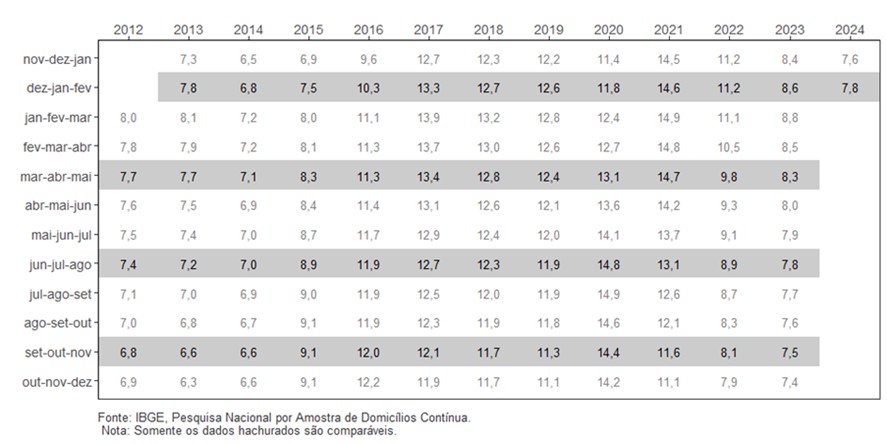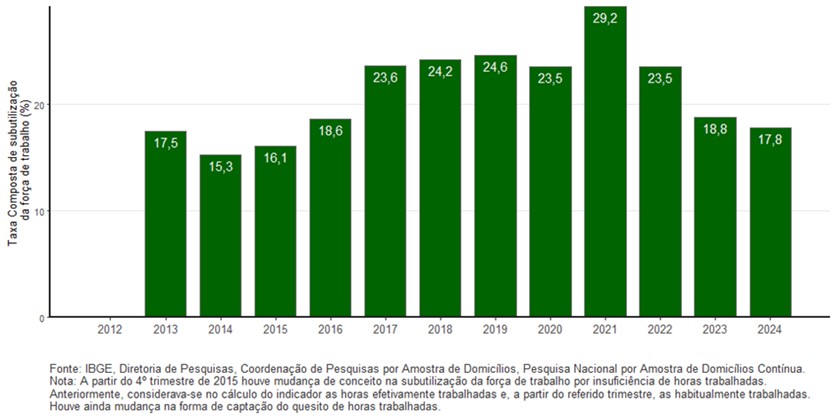Continuous PNAD: unemployment rate is 7.8% and underutilization rate is 17.8% in the quarter ended in February
March 28, 2024 09h00 AM | Last Updated: April 01, 2024 03h04 PM
The unemployment rate (7.8%) rose 0.3 percentage points (pp) in the quarter ended in February 2024 compared to the quarter ended in November 2023 and decreased 0.7 pp compared to the quarter ended in February 2023 ( 8.6%).
| Indicator/Period | Dec-Jan-Feb 2024 | Sept-Oct-Nov 2023 | Dec-Jan-Feb 2023 |
|---|---|---|---|
| Unemployment rate | 7.8% | 7.5% | 8.6% |
| Underutilization rate | 17.8% | 17.4% | 18.8% |
| Usual real eraningsl | R$ 3,110 | R$ 3,076 | R$ 2,982 |
| Change of usual earnings in relation to: | 1.1% | 4.3% | |
The unemployed population (8.5 million) grew 4.1% (332 thousand more persons) in the quarter and fell 7.5% (689 thousand less persons) in the year.
The employed population (100.250 million) did not change significantly in the quarter and grew 2.2% (2.1 million more persons) in the year. The employment level (percentage of employed persons in the population of working age) was 57.1%, falling 0.3 pp compared to the previous moving quarter (57.4%) and rising 0.7 pp in the annual comparison (56 .4%).
The composite underutilization rate (17.8%) grew 0.5 pp in the quarter and fell 1 pp in the annual comparison. The underutilized population (20.6 million persons) grew 3.4% (or 675 thousand more persons) in the quarter and fell 4.5% (or 963 thousand less persons) in the year.
The time-related underemployed population worked (5.1 million) fell 6.9% in the quarterly comparison and had no significant change in the year.
The population outside the labor force grew 0.4% in the quarterly comparison and did not change significantly in the year.
The discouraged population (3.7 million) grew 8.7% (293 thousand more persons) compared to the previous moving quarter and fell 7.5% (299 thousand less persons) in the year. The percentage of the discouraged or discouraged persons in the labor force (3.3%) rose 0.3 pp in the quarter and fell 0.3 pp in the year.
The number of employees with a work contract in the private sector (except domestic workers) reached 37.995 million, a new record in the Continuous PNAD series, although it did not change significantly in the quarter. During the year, this contingent grew 3.2% (1.2 million more). The number of employees without a labor contract in the private sector (13.3 million) did not change significantly in the quarter and grew 2.6% (331 thousand more persons) in the year.
The number of self-employed workers (25.4 million persons) remained stable in both comparisons, as did the number of domestic workers (5.9 million persons) and employers (4.2 million persons). The number of employees in the public sector (12.0 million) remained stable in the quarter and grew 2.4% (279 thousand more persons) in the year.
The informality rate was 38.7% of the employed population (or 38.8 million informal workers) against 39.2% in the previous moving quarter and 38.9% in the same moving quarter of 2023.
The usual real income from all jobs (R$3,110) grew 1.1% in the quarter and 4.3% in the year.
The usual real wage bill (R$307.3 billion) reached a new record in the time series started in 2012, although it did not vary significantly in the quarter. This indicator grew 6.7% (more R$19.3 billion) in the annual comparison.
Unemployment Rate - Brazil - 2012/2024

In the moving quarter from November to January 2024, the workforce (employed and unemployed persons) was estimated at 108.8 million persons, showing no significant change compared to the quarter ended in November 2023 and growing 1.3% (but 1.4 million persons) in the year.
The population employed by groups of activities, compared to the previous moving quarter, increased only in Transportation, storage and mailing (5.1%, or 285 thousand more persons). There were reductions in: Agriculture, livestock, forestry, fishing and aquaculture (3.7%, or less 308 thousand persons) and Public administration, defense, social security, education, human health and social services (2.2%, or 395 thousand less persons). The eight other groups did not have significant changes in this comparison.
Compared to the same moving quarter of 2023, employment grew in: General Industry (3.1%, or 393 thousand more persons), Transportation, storage and mailing (7.7%, or 415 thousand more persons), Information, Communication and Financial, Real Estate, Professional and Administrative Activities (6.5%, or 775 thousand more persons) and Public administration, defense, social security, education, human health and social services (2.8%, or 479 thousand more persons). There was a reduction in the group of Agriculture, livestock, forestry production, fishing and aquaculture (5.6%, or 472 thousand less persons). The remaining five groups did not have significant changes in this comparison.
Composite underutilization rate – Quarters from November to January – Brazil – 2013 a 2024 (%)

Regarding the usual real average earnings (R$ 3,110), compared to the previous moving quarter, there was an increase in the average earnings in the following groups of activity: Lodging and food (4.4%, or + R$ 88) Public administration, defense, security social, education, human health and social services (2.3%, or + R$96) and Domestic services (2.8%, or + R$32). The other groups did not show significant change.
Compared to the same moving quarter of 2023, there were increases in earnings in: Industry (7.3%, or + R$209), Trade, repair of motor vehicles and motorcycles (3.9%, or + R$96) Transportation, storage and mailing (4.9%, or + R$137) Public administration, defense, social security, education, human health and social services (3.9%, or + R$166) and Domestic services (2.4%, or + R$28). The other groups did not show significant change.
Among the employment categories, in relation to the previous quarter, the following categories showed an increase: Domestic worker (2.8%, or more R$32) and Worker in the public sector (including statutory and military servants) (4.3%, or more R$197). The other categories did not show significant change.
The comparison with the same moving quarter of 2023 indicated an increase in the categories: Worker with a formal employment contract (2.2%, or more R$62), Worker without a formal employment contract (8.9%, or more R$178 ), Domestic worker (2.4%, or more R$28), Worker in the public sector (including statutory and military servants) (5.2%, or more R$238) and Self-employed (4.5%, or more R$107).

